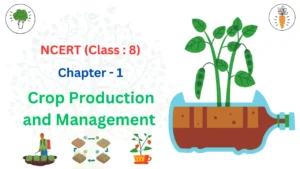
Crop production and management involve soil preparation, sowing, irrigation, fertilization, pest control, and harvesting to ensure high agricultural yield.
Crop:- same kind of plant are cultivated at one place on a large scale known as Crop.
Types of crops :-
- Kharif:- Sown in the rainy season(june-september). For example:- Paddy, Cotton etc
- Ravi:- Sown in winter season (October – March) For example:- Wheat, Gram, Peas etc.
Agricultural Practices :-
(i) Preparation of soil
(ii) Sowing
(iii) Adding manure and fertilisers
(iv) Irrigation
(v) Protecting from weeds
(vi) Harvesting
(vii) Storage
Preparation of soil:- by tilling or Ploughing
Tilling or ploughing:-The process of loosening and turning of the soil is called tilling or ploughing. This is done by using a plough, hoe, cultivator etc.
The substances which are added to the soil in the form of nutrients for the healthy growth of plants are called Manure and Fertilisers.
Manure:- It is an organic substance obtained from the decomposition of plant or animal wastes.
Fertilizer:– Fertilisers are chemicals which are rich in a particular nutrient. It is produce in factories. for example:- Urea, Ammonium Sulphate, NPK etc.
Manuring :- Farmers have to add manure to the fields to replenish the soil with nutrients. This process is called manuring.
Difference between Manure and Fertilisers:-
| Manure | Fertiliser |
| Organic Substance and can be prepared in the field | Inorganic Substance and produce in factories |
| It is natural and obtained from the decomposition of plant or animal wastes. | It is man made and rich in particular nutrients |
| Manure provides a lot of humus to the soil. | Fertiliser does not provide any humus to the soil |
| Manure is relatively less rich in plant nutrients.
|
Fertilisers are very rich in plant nutrients like nitrogen, phosphorus and potassium. |
Pros of Manure :- The organic manure is considered better than fertilisers. This is because
- It enhances the water holding capacity of the soil.
- It makes the soil porous due to which exchange of gases becomes easy.
- It increases the number of friendly microbes.
- It improves the texture of the soil.
Irrigation:- The supply of water to crops at regular intervals is called Irrigation.
Sources of irrigation:- wells, tubewells, ponds, lakes, rivers, dams and canals.
Traditional Methods of
Irrigation:-
- chain pump
- moat (pulley-system)
- rahat (Lever system)
- dhekli
Modern method of irrigation:-
- Sprinkler System: This system is more useful on the uneven land where sufficient water is not available.
- Drip system : In this system, the water falls drop by drop directly near the roots. So it is called a drip system. It is a boon in regions where availability of water is poor.
Weeds :- Other undesirable plants may grow naturally along with the crop. These undesirable plants are called weeds.
Weeding :- The removal of weeds is called weeding.
Harvesting :– The cutting of crop after it is mature is called harvesting.
Threshing :- In the harvested crop, the grain seeds need to be separated from the chaff. This process is called threshing.
Harvest Festival :- Pongal, Baishakhi , Holi, Diwali, Nabanya , Bihu etc.
Storage :- Proper storage of grains is necessary to protect them from pests and microorganisms.
Animal Husbandry :- Food is also obtained from animals for which animals are reared. This is called animal husbandry.
